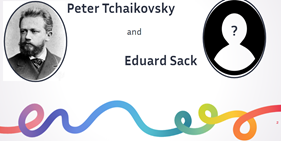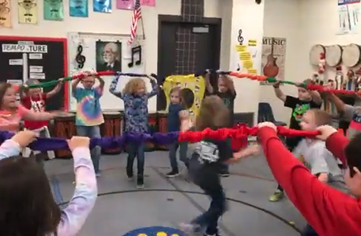
LGBT+ History Month in the Primary Music Class
with Chris Andrews - @prepschoolmusic
|
During the third verse of the “Johnny’s Hammer” song, I notice a distracted boy on the other side of the circle. To get his attention I substitute his name into the song: “Harry taps with four hammers, four hammers, four hammers…” He lights up and immediately makes up his own actions: both arms up, he squats and repeatedly bangs his bottom on the floor in time to the music. The other children giggle and instantly join in and I’m left with an entire class of seven-year-olds singing and bouncing their backsides on the carpet, insisting they all get a turn! |
Using childrens’ own names, experiences or ideas in classroom songs doesn’t just guarantee a smile, it makes them feel deeply valued and respected. Harry’s name appeared in the song, which existed for others to enjoy and share. This built his pride and self-esteem in a meaningful way - and the joy is infectious!
For LGBT+ children and families, opportunities to access positive representation has been historically limited. Only in September 2020 did LGBT+ education become compulsory in all British schools, but a recent poll of 6,179 teachers found that just 29% were “completely comfortable” teaching it. (1)
Why is it difficult?
For those of us at British schools between 1986 and 2003 (myself included) our own LGBT+ education was non-existent. It was prohibited under Section 28 - legislation which stopped teachers from “promoting homosexuality.” Without recognition or inclusion, and with teachers essentially banned from reprimanding the use of homophobic slurs, bullying flourished. Educational silence on LGBT+ teaching is not neutral and the message was clear: it taught us there was something fundamentally shameful and inappropriate about LGBT+ people. (2)
Thankfully, things have moved on, but that same generation is now being asked to teach LGBT+ inclusion and studies show the impact of Section 28 is still felt today. For many, there is lingering cautiousness and vigilance around LGBT+ representation in schools - especially at primary level - with links to a pervasive myth: that talking to children about anything LGBT+ means talking to them about something sexual.
Even for teachers who know better, there might be anxiety over the level of parental acceptance and understanding. Objections sprang up in 2019 over Andrew Moffat’s “No Outsiders” school programme in Birmingham that drove parental protests and extended news coverage - giving yet more air-time to grossly inaccurate views on primary education. As a gay educator, what I find sad is that the perceived over-sexualisation of the LGBT+ community reduces the full, human lives and experiences of its people into a pigeonhole, robbing children of a more rich, diverse and culturally relevant education.
In reality, relationships education in primary schools teaches healthy relationships, boundaries, respect for others and that families come in different shapes and sizes. (3) This is all good preparation for life in modern Britain.
Why is it important?
Nobody is exempt from their educational experience and attitudes we hear growing up can be deeply rooted. I was nervous teaching an LGBT+ themed song for the first time (perhaps LGBT+ teachers are even more vigilant, as we had to be in our own schooling?) But our history shows homophobia is taught so LGBT+ inclusion is essential if we don’t want to pass myths or anxieties about it onto our children.
LGBT+ families are normal life for many children; 1 in 6 adoptions were to same-sex couples in 2020 and the numbers are going up (4). Other children have LGBT+ family members, friends or teachers and statistically there is at least one LGBT+ student in every class you teach. They may not realise it yet, but they carry forward what teachers do (or don’t) say about it. For children of LGBT+ families it gives them the opportunity to feel seen, proud and supported. As children move into secondary schools, we know that LGBT-inclusive education significantly reduces stigma and bullying, but this 2021 study shows there is still more work to do. (5)
What can I do in music lessons?
We want to normalise healthy LGBT+ relationships and references because it is normal for LGBT+ people and their children! When it comes up in classroom repertoire, I personally avoid making a fanfare about it, aim to keep it fun, factual and relevant to the context of the musical learning. (A fanfare or celebration might be saved for PRIDE month in June!) We don’t need to revise everything - just to make children aware that LGBT+ people and families exist as a part of the world, in different times, places and musical cultures.
Below are a few possible activities, but even the smallest thing can make a difference. Two years ago, a student came out after a rehearsal. He said he’d seen a photograph in my office of me and my partner so “thought it would be ok to say.” LGBT+ children are vulnerable; the world still has a lot of negative representations, so if we can counterbalance those with more positive frames of reference, we should.
In my experience using LGBT+ materials in class, children are much less bothered about it than you might expect. Younger children rarely ask questions; at least about this! My older students got a chance to mention LGBT+ people in their own lives. By using LGBT+ inclusive material, it tells children they can talk about it, if they want to.
Of the limited LGBT+ musical materials I found online, they obviously focus on LGBT-inclusion, but as most are written by charities - not music educators - some lack musical value. To truly normalise LGBT+ people in the music curriculum we need materials that have those positive references, but are also an embedded part of the curriculum, furthering musical learning.
So… where are all the songs?
This is where history bites us. The oppression of LGBT+ people has meant their erasure in folk songs, nursery rhymes and traditional songbooks. Modern repertoire is better in terms of representation, but pop songs with LGBT+ themes can include vocal ranges and techniques beyond what is healthy for younger voices. There is a wealth of music written by LGBT+ composers, which might be a better starting point, but many activities I found online were more passive, rather than active, listening.
I hope the activities below offer a good starting point for your classes, they are LGBT-inclusive and build on children's musical skills. Most include ideas on how to revisit the same material in later lessons. Select and adapt whatever best suits the needs and abilities of your class, and most importantly: have fun!
Love Makes A Family |

Bursting with colourful imagery, Love Makes A Family by Sophie Beer illustrates diverse families spending time together. Two mothers tuck children into bed, two fathers are woken up by loud instruments and an older family member celebrates a special occasion with cake.
After reading and discussing the book, learn the song below:

Teaching the song:
Most children can pick up this simple song by ear when modelled. Tap your knees with both hands on the beat as you sing, asking the children to join in with the actions. When repeated, change where you show the beat and encourage the class to join in with the singing. This is a great song to practise their “gentle voices” so remember to sing softly, and not too fast!
Ideas for further learning:
- Children’s ideas: Ask the children for their own ideas; who do they have in their own families? E.g.
Fit their ideas into the song as best you can, ideally without editing their wording. The important thing is to include their ideas and keep a steady beat.
Older children may find the book too young, so the song can be prefixed with a more direct discussion, supported by pictures of different families: who is in their own families? How are families different? LGBT+ families, adoptive parents etc. - use the experiences of your class. The song can be taught as described above, but moved onto more challenging activities below:
|
Low (do) Tap legs |
Mid (re) Clap hands |
High (mi) High clap against partner |
Can they go back to singing the original lyrics of the song while still performing the pitch actions?

For a class challenge, you could extend this further and have children in a circle of partners (see image), perform the actions as above, then ask them to jump 180-degrees on the spot, on the final silent beat of the song (rest) so they can sing it again facing a new partner.
This Day in June |

Book: This Day in June
Gayle E. Pitman / Kristyna Litten
Suitable for introducing pride to EYFS|
Video by Pop’n’Olly |
Video by The History Channel |
After learning a little of pride history children can learn “This Day in June,” a song by Matthew Stensrud, an Orff Teacher in Virginia, USA, based on a book of the same name by Gayle E. Pitman. This short, catchy song can be made into a musical challenge - click the video below to learn it.
Click to watch song video - including ideas for extending learning

Other ideas

Here is the notation for the original actions. For young classes, just keeping the beat may be challenging enough, but for older students who are comfortable with crotchets and quavers they could write their own rhythm and actions, making it as difficult as they like!
|
Here is a clip of a Year 6 class performing the original actions as a round.  They decided to perform the clap against a partner, and some children are performing the actions backwards (in “retrograde”) |
Tchaikovsky: March from “The Nutcracker” |
One of the best-loved Russian composers, Pyotr Tchaikovsky, was gay - as revealed in private letters to his brother, Modest, who was gay too! His overture to Romeo & Juliet was dedicated to Eduard Sack, with whom the composer had a meaningful, romantic relationship. Letters detailing the relationship were suppressed by the Soviet government, only being released and translated into English (without censorship) in 2009.
Click below for a copy of their story, which can be shared with classes. This links directly into LGBT+ history, including historical hardships, and the impact on the music. A parachute game follows using Tchaikovsky’s March to practise beat, rhythm and musical form.

|
CLICK HERE to save a copy to your Google Drive |
The use of a rainbow parachute in this activity might also prompt a discussion of the rainbow flag that students may have seen before!
Game
|
Use a rainbow Co-Oper Band or parachute, and a copy of the music. Children hold the parachute and move in a circle: 
On the next 32 counts:
Repeat until the music is complete! |

Watson Elementary School (Hastings, Nebraska)
Activity from “Parachutes, Ribbons, and Scarves: Oh My!" by Artie Almeida
|
For more ideas follow Chris on Instagram / Facebook: @prepschoolmusic
|
|
References:
Clip arts by Artifex Graphics & Dancing Crayon Designs |
|
Further information for schools: https://www.diversityrolemodels.org/ This company are able to provide people to run school assemblies and workshops Lists of LGBT+ children’s book, curricula and training https://www.mykidisgay.com/blog/when-your-student-comes-out-to-you https://www.sec-ed.co.uk/best-practice/helping-gay-students-who-come-out-at-school/ Advice on what to do if a students comes out to you Helplines and support |
- Choosing a selection results in a full page refresh.
!






